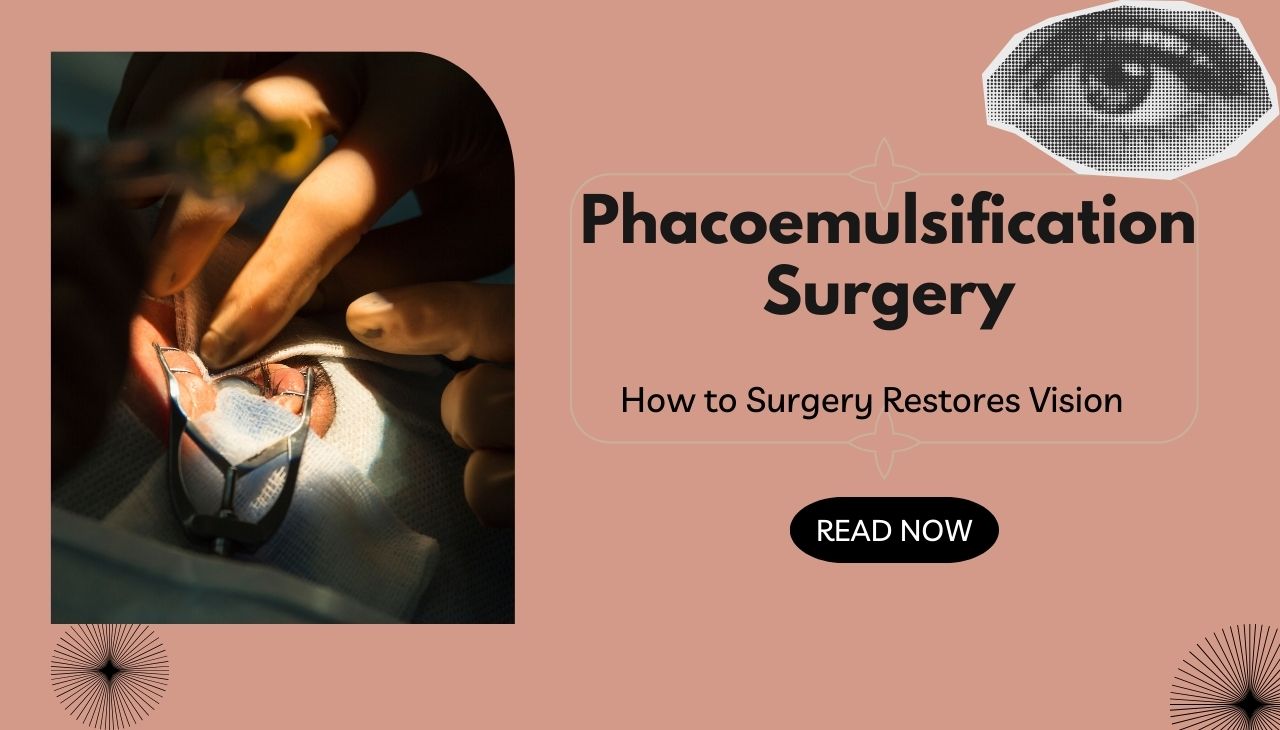Introduction
Cataracts are a leading cause of vision impairment, especially in older adults. However, advancements in medical technology have led to highly effective surgical treatments for cataracts, one of which is phacoemulsification. This minimally invasive technique has transformed the way cataracts are treated and has restored vision for millions around the world. In this blog, we will delve into what phacoemulsification surgery is, how it works, its benefits, and the important factors to consider before undergoing the procedure.
Understanding Phacoemulsification Surgery
What is Phacoemulsification?
Phacoemulsification, often referred to as “phaco,” is a modern, state-of-the-art cataract surgery technique used to remove the clouded lens from the eye, a condition known as cataract. In this procedure, the surgeon makes a small incision in the cornea, inserts a tiny probe that emits ultrasound waves, and breaks the cloudy lens into tiny fragments. These fragments are then aspirated (suctioned) out of the eye. Afterward, an artificial intraocular lens (IOL) is implanted to restore clear vision.
Why is Phacoemulsification Preferred?
Phacoemulsification is the most widely used method for cataract surgery because of its many advantages. It is minimally invasive, requires only a small incision, and involves a quick recovery time compared to traditional cataract surgery. Most patients experience significantly improved vision almost immediately after the procedure.

Causes and Symptoms of Cataracts
What Causes Cataracts?
Cataracts primarily develop due to aging. As we age, the proteins in the eye’s lens start to break down and clump together, forming cloudy areas that obstruct vision. Other causes include eye injuries, prolonged exposure to ultraviolet light, genetic predisposition, diabetes, smoking, and the use of certain medications like corticosteroids.
Common Symptoms of Cataracts
The symptoms of cataracts can vary depending on the severity of the clouding. Common signs include:
- Blurred or cloudy vision
- Difficulty seeing at night or in low light
- Sensitivity to glare or bright lights
- Double vision in one eye
- Fading or yellowing of colors
These symptoms can gradually worsen over time and may interfere with everyday tasks such as reading, driving, and recognizing faces. When cataracts significantly impair vision, phacoemulsification surgery becomes the most effective solution.
Treatment and Solutions: Phacoemulsification Surgery
How Does Phacoemulsification Work?
As mentioned, phacoemulsification is performed by making a small incision in the eye, typically no more than 2-3 millimeters in size. Once the cataract is broken down into smaller pieces using ultrasound energy, these fragments are safely suctioned out. Afterward, a foldable intraocular lens (IOL) is inserted to replace the cloudy natural lens. The lens is chosen based on the patient’s needs, such as whether they want to reduce their dependency on glasses.
What Are the Benefits of Phacoemulsification Surgery?
- Quick Recovery: Patients usually experience minimal pain and are able to resume daily activities within a few days.
- Improved Vision: The majority of patients experience a significant improvement in their vision, often the day after surgery.
- Minimally Invasive: The small incision reduces the risk of complications and allows for faster healing.
- Customization: The choice of intraocular lens can be tailored to the patient’s vision needs, offering options for near, intermediate, and far distances.
- No Need for Stitches: Since the incision is small, stitches are usually not required, further speeding up the healing process.
What Are the Risks and Side Effects?
Like all surgeries, phacoemulsification comes with some risks. These include infection, bleeding, inflammation, and potential damage to surrounding tissues. However, complications are rare, and most patients experience a smooth recovery. It’s important to follow all post-operative care instructions provided by the surgeon to ensure a successful outcome.
Additional Insights: Expert Recommendations for Cataract Surgery
Choosing the Right Surgeon
Phacoemulsification is a delicate procedure that requires precision. It is crucial to choose a qualified, experienced ophthalmologist with expertise in cataract surgeries. Look for a surgeon who specializes in the latest techniques and uses advanced equipment for cataract removal.
Pre-Surgery Preparations
Before undergoing cataract surgery, your ophthalmologist will conduct a thorough eye examination to evaluate the severity of your cataract and determine the most suitable IOL for you. This examination may include measuring the size and shape of your eye, checking your overall eye health, and testing your vision.
Post-Surgery Care
Following surgery, patients are typically prescribed eye drops to prevent infection and reduce inflammation. It’s important to attend follow-up appointments to monitor healing and ensure the best possible outcome. Patients should avoid rubbing their eyes and protect the eye from dust or other irritants during the healing period.
Laxmi Eye Institute: Expert Eye Care You Can Trust
If you’re considering phacoemulsification surgery to restore your vision, look no further than Laxmi Eye Hospital. With over 30 years of experience in the eye care industry, Laxmi Eye Hospital is one of the largest and most trusted chains of eye hospitals in Mumbai. Their expertise in cataract surgery, especially phacoemulsification, ensures that you receive the highest quality care and treatment.
Laxmi Eye Institute offers comprehensive eye care under one roof, including services such as LASIK, glaucoma treatment, retina care, and pediatric ophthalmology. Their highly skilled and experienced doctors use state-of-the-art diagnostic equipment to provide accurate assessments and effective treatments.
Laxmi Eye Institute has a long history of training ophthalmologists in specialty fellowships and offering internationally recognized services. With clinics located in Panvel, Kharghar, Kamothe, and Dombivli, the hospital is conveniently accessible to patients across the region.
For consultations and appointments, visit any of their locations:
- Dombivli: 1st Floor, Laxmi Eye Institute, SS Business Park, Gharda Circle, Dombivli East, Mumbai
- Kharghar: Office 108-110, Anant CHS, Sector 04, Kharghar, Navi Mumbai
- Panvel: Mulla Hamid Rd, Old Panvel, Navi Mumbai
- Kamothe: Near ICICI Bank, Kamothe, Navi Mumbai
You can easily book an appointment by calling or visiting their website for more details.
Frequently Asked Questions (FAQs)
- How long does phacoemulsification surgery take? Phacoemulsification typically takes around 15-30 minutes.
- Is phacoemulsification painful? No, the procedure is performed under local anesthesia, so you will not feel pain during surgery.
- How soon will I be able to see clearly after the surgery? Most patients notice an improvement in vision the day after surgery.
- Are there any age restrictions for cataract surgery? Phacoemulsification is suitable for adults of all ages, though it is most common in older adults.
- Do I need to wear glasses after surgery? Depending on the type of intraocular lens you receive, you may still need glasses for certain tasks like reading.
Conclusion
Phacoemulsification surgery has revolutionized cataract treatment, offering a safe and effective solution for those suffering from cloudy vision. With a high success rate and quick recovery time, this procedure is the go-to option for cataract removal. If you’re considering cataract surgery, seek professional advice from trusted institutions like Laxmi Eye Hospital, where expert ophthalmologists are dedicated to restoring your vision. Don’t wait—take the first step towards clearer sight today!




